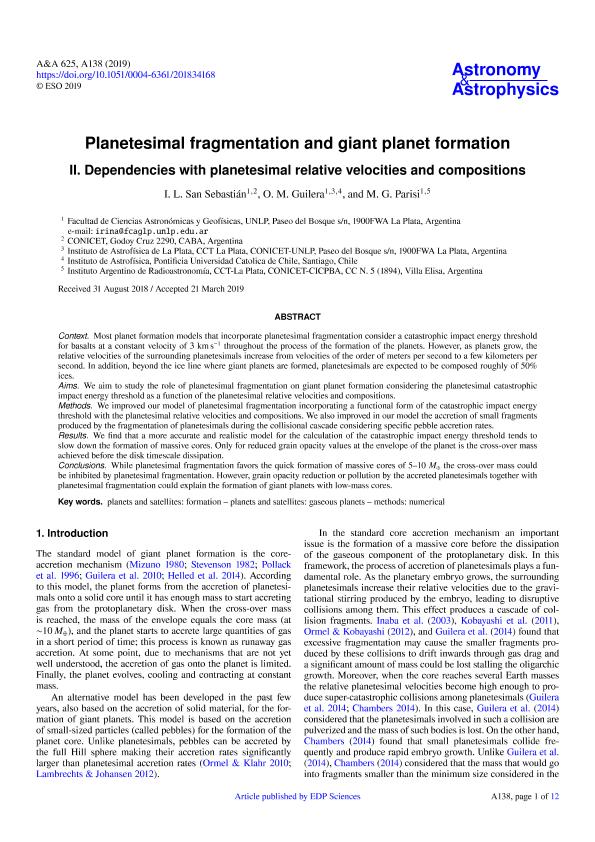Mostrar el registro sencillo del ítem
dc.contributor.author
San Sebastián, Irina Luciana

dc.contributor.author
Guilera, Octavio Miguel

dc.contributor.author
Parisi, Mirta Gabriela

dc.date.available
2020-11-11T18:08:32Z
dc.date.issued
2019-05
dc.identifier.citation
San Sebastián, Irina Luciana; Guilera, Octavio Miguel; Parisi, Mirta Gabriela; Planetesimal fragmentation and giant planet formation; EDP Sciences; Astronomy and Astrophysics; 625; 5-2019; 1-12
dc.identifier.issn
0004-6361
dc.identifier.uri
http://hdl.handle.net/11336/118175
dc.description.abstract
Context. Most planet formation models that incorporate planetesimal fragmentation consider a catastrophic impact energy threshold for basalts at a constant velocity of 3 km/s throughout the process of the formation of the planets. However, as planets grow, the relative velocities of the surrounding planetesimals increase from velocities of the order of meters per second to a few kilometers per second. In addition, beyond the ice line where giant planets are formed, planetesimals are expected to be composed roughly of 50% ices.Aims. We aim to study the role of planetesimal fragmentation on giant planet formation considering the planetesimal catastrophic impact energy threshold as a function of the planetesimal relative velocities and compositions.Methods. We improved our model of planetesimal fragmentation incorporating a functional form of the catastrophic impact energythreshold with the planetesimal relative velocities and compositions. We also improved in our model the accretion of small fragments produced by the fragmentation of planetesimals during the collisional cascade considering specific pebble accretion rates.Results. We find that a more accurate and realistic model for the calculation of the catastrophic impact energy threshold tends toslow down the formation of massive cores. Only for reduced grain opacity values at the envelope of the planet is the cross-over massachieved before the disk timescale dissipation.Conclusions. While planetesimal fragmentation favors the quick formation of massive cores of 5?10 Earth masses the cross-over mass could be inhibited by planetesimal fragmentation. However, grain opacity reduction or pollution by the accreted planetesimals together with planetesimal fragmentation could explain the formation of giant planets with low-mass cores.
dc.format
application/pdf
dc.language.iso
eng
dc.publisher
EDP Sciences

dc.rights
info:eu-repo/semantics/openAccess
dc.rights.uri
https://creativecommons.org/licenses/by-nc-sa/2.5/ar/
dc.subject
PLANETS AND SATELLITES: FORMATION
dc.subject
PLANETS AND SATELLITES: GASEOUS PLANETS
dc.subject
METHODS: NUMERICAL
dc.subject.classification
Astronomía

dc.subject.classification
Ciencias Físicas

dc.subject.classification
CIENCIAS NATURALES Y EXACTAS

dc.title
Planetesimal fragmentation and giant planet formation
dc.type
info:eu-repo/semantics/article
dc.type
info:ar-repo/semantics/artículo
dc.type
info:eu-repo/semantics/publishedVersion
dc.date.updated
2020-11-05T15:36:35Z
dc.journal.volume
625
dc.journal.pagination
1-12
dc.journal.pais
Francia

dc.journal.ciudad
Paris
dc.description.fil
Fil: San Sebastián, Irina Luciana. Universidad Nacional de La Plata. Facultad de Ciencias Astronómicas y Geofísicas; Argentina. Consejo Nacional de Investigaciones Científicas y Técnicas. Centro Científico Tecnológico Conicet - La Plata; Argentina
dc.description.fil
Fil: Guilera, Octavio Miguel. Universidad Nacional de La Plata. Facultad de Ciencias Astronómicas y Geofísicas; Argentina. Consejo Nacional de Investigaciones Científicas y Técnicas. Centro Científico Tecnológico Conicet - La Plata. Instituto de Astrofísica La Plata. Universidad Nacional de La Plata. Facultad de Ciencias Astronómicas y Geofísicas. Instituto de Astrofísica La Plata; Argentina. Pontificia Universidad Católica de Chile; Chile
dc.description.fil
Fil: Parisi, Mirta Gabriela. Provincia de Buenos Aires. Gobernación. Comisión de Investigaciones Científicas. Instituto Argentino de Radioastronomía. Consejo Nacional de Investigaciones Científicas y Técnicas. Centro Científico Tecnológico Conicet - La Plata. Instituto Argentino de Radioastronomía; Argentina. Universidad Nacional de La Plata. Facultad de Ciencias Astronómicas y Geofísicas; Argentina. Consejo Nacional de Investigaciones Científicas y Técnicas. Centro Científico Tecnológico Conicet - La Plata; Argentina
dc.journal.title
Astronomy and Astrophysics

dc.relation.alternativeid
info:eu-repo/semantics/altIdentifier/url/https://arxiv.org/abs/1903.12288
dc.relation.alternativeid
info:eu-repo/semantics/altIdentifier/doi/http://dx.doi.org/10.1051/0004-6361/201834168
Archivos asociados
